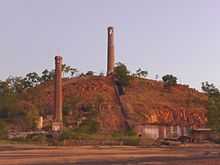Chillagoe smelters

The Chillagoe Smelter operated in the early 1900s. At this time it was the centre of a thriving mining industry that brought wealth and development to the Chillagoe area in Queensland, Australia.
By June 1901, when the railway was completed, Chillagoe was a flourishing town. The railway enabled equipment for the large, innovative Chillagoe Smelters to become operative by September 1901.[1] The Chillagoe Railway & Mining Company equipped its work sites with the most up-to-date machinery and the surrounding mines at Mungana, Zillmanton and Redcap worked on a large scale. At times, the mines, railway and smelter provided employment for up to 1,000 workers.
Chillagoe Smelter operated until 1943 and in its 40 odd year lifetime treated 1.25 million tons of ore, yielded 60,000 tons of copper, 50,000 tons of lead, 181 tons of silver and 5 tons of gold. By 1943, other smelters were built closer to the then major ore producing areas such as Mount Isa. Easy access to these areas outweighed the economic usefulness of the state run Chillagoe Smelter. In 1950, the buildings and equipment were auctioned. Today the site is managed by Queensland Parks and Wildlife Service.
Heritage listing
The Chillagoe Smelter was added to the Queensland Heritage Register on 21 October 1992.[2]
See also
References
- ↑ "Chillagoe and Chillagoe Shire". Queensland Places. Centre for the Government of Queensland. Retrieved 30 July 2011.
- ↑ "Chillagoe Smelters (entry 15450)". Queensland Heritage Register. Queensland Heritage Council.